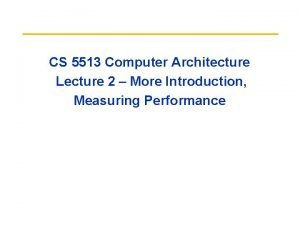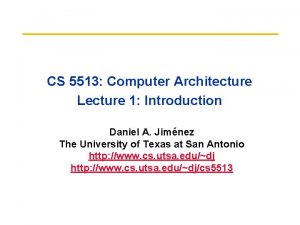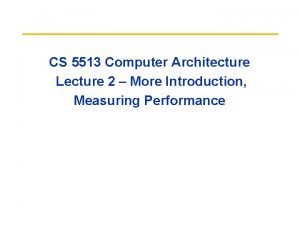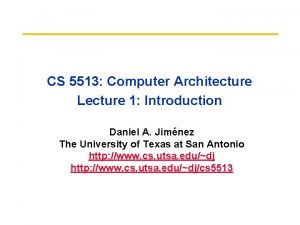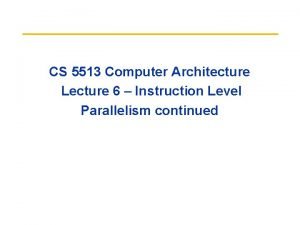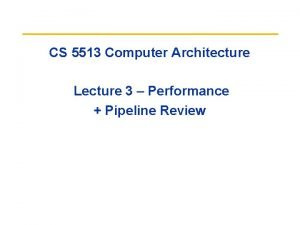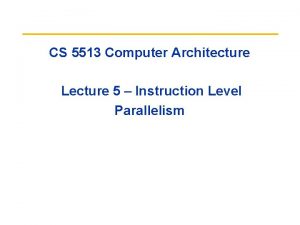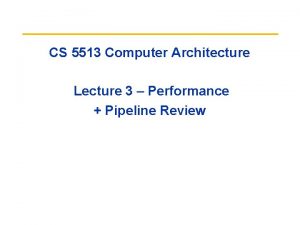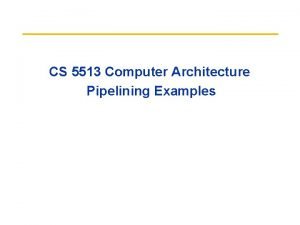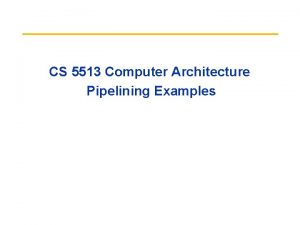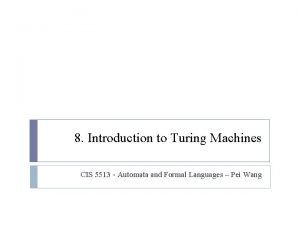CS 5513 Computer Architecture Lecture 2 More Introduction


















- Slides: 18

CS 5513 Computer Architecture Lecture 2 – More Introduction, Measuring Performance

Review: Computer Architecture brings • • Other fields often borrow ideas from architecture Quantitative Principles of Design 1. 2. 3. 4. 5. • Careful, quantitative comparisons – – • • Take Advantage of Parallelism Principle of Locality Focus on the Common Case Amdahl’s Law The Processor Performance Equation Define, quantity, and summarize relative performance Define and quantity relative cost Define and quantity dependability Define and quantity power Culture of anticipating and exploiting advances in technology Culture of well-defined interfaces that are carefully implemented and thoroughly checked

Outline • • • Review Technology Trends Define, quantity, and summarize relative performance

Moore’s Law: 2 X transistors / “year” • “Cramming More Components onto Integrated Circuits” – Gordon Moore, Electronics, 1965 • # on transistors / cost-effective integrated circuit double every N months (12 ≤ N ≤ 24)

Tracking Technology Performance Trends • Drill down into 4 technologies: – – Disks, Memory, Network, Processors • Compare ~1980 Archaic (Nostalgic) vs. ~2011 Modern (Newfangled) – Performance Milestones in each technology • Compare for Bandwidth vs. Latency improvements in performance over time • Bandwidth: number of events per unit time – E. g. , M bits / second over network, M bytes / second from disk • Latency: elapsed time for a single event – E. g. , one-way network delay in microseconds, average disk access time in milliseconds

Disks: Archaic(Nostalgic) v. Modern(Newfangled) • • • CDC Wren I, 1983 3600 RPM 0. 03 GBytes capacity Tracks/Inch: 800 Bits/Inch: 9550 Three 5. 25” platters • Bandwidth: 0. 6 MBytes/sec • Latency: 48. 3 ms • Cache: none • • • Seagate ST 33000651 AS, 2011 7200 RPM (2 X) 2 TB (66, 666 X) Tracks/Inch: 1, 800, 000 (2250 X) Bits/Inch: 14, 924, 000 (1562 X) Five 2. 5” platters (in 3. 5” form factor) Bandwidth: 149 MBytes/sec (248 X) Latency: 4. 2 ms (11. 5 X) Cache: 64 MBytes

Memory: Archaic (Nostalgic) v. Modern (Newfangled) • 1980 DRAM (asynchronous) • 0. 06 Mbits/chip • 64, 000 xtors, 35 mm 2 • 16 -bit data bus per module, 16 pins/chip • 13 Mbytes/sec • Latency: 225 ns • (no block transfer) • 2011 DDR 3 -2133 N Synchr. (clocked) DRAM • 32, 768 Mbits/chip (546, 133 X) • > 1 billion xtors, 495 mm 2 • 64 -bit data bus per DIMM, 240 pins/DIMM (4 X) • 17, 066 Mbytes/sec (1312 X) • Latency: 13 ns (17 X) • Block transfers (page mode)

CPUs: Archaic (Nostalgic) v. Modern (Newfangled) • • 1982 Intel 80286 12. 5 MHz 2 MIPS (peak) Latency 320 ns 134, 000 xtors, 47 mm 2 16 -bit data bus, 68 pins Microcode interpreter, separate FPU chip • (no caches) • • 2011 Intel Xeon E 7 -8870 2400 MHz (192 X) 7200 MIPS (peak) (3600 X) Latency 0. 416 ns (768 X) 2. 6 billion xtors, 513 mm 2 64 -bit data bus, 423 pins 3 -way superscalar, multithreaded, dynamic translate to RISC, deep pipeline, Out-of-Order execution • On-chip 32 KB Data caches, 64 KB Instr. cache, 30 MB last-level cache

Outline • • • Review Technology Trends: Culture of tracking, anticipating and exploiting advances in technology Define, quantity, and summarize relative performance

Definition: Performance • Performance is in units of things per sec – bigger is better • If we are primarily concerned with response time performance(x) = 1 execution_time(x) " X is n times faster than Y" means Performance(X) n = Execution_time(Y) = Performance(Y) Execution_time(X)

Performance: What to measure • Usually rely on benchmarks vs. real workloads • To increase predictability, collections of benchmark applications, called benchmark suites, are popular • SPECCPU: popular desktop benchmark suite – – CPU only, split between integer and floating point programs SPECint 2000 has 12 integer, SPECfp 2000 has 14 integer pgms SPECCPU 2006 to be announced Spring 2006 SPECSFS (NFS file server) and SPECWeb (Web. Server) added as server benchmarks • Transaction Processing Council measures server performance and cost-performance for databases – – TPC-C Complex query for Online Transaction Processing TPC-H models ad hoc decision support TPC-W a transactional web benchmark TPC-App application server and web services benchmark

How Summarize Suite Performance (1/5) • Arithmetic average of execution time of all pgms? – But they vary by 4 X in speed, so some would be more important than others in arithmetic average • Could add a weights per program, but how pick weight? – Different companies want different weights for their products • SPECRatio: Normalize execution times to reference computer, yielding a ratio proportional to performance = time on reference computer time on computer being rated

How Summarize Suite Performance (2/5) • If program SPECRatio on Computer A is 1. 25 times bigger than Computer B, then • Note that when comparing 2 computers as a ratio, execution times on the reference computer drop out, so choice of reference computer is irrelevant

How Summarize Suite Performance (3/5) • Since ratios, proper mean is geometric mean (SPECRatio unitless, so arithmetic meaningless) 1. Geometric mean of the ratios is the same as the ratio of the geometric means 2. Ratio of geometric means = Geometric mean of performance ratios choice of reference computer is irrelevant! • These two points make geometric mean of ratios attractive to summarize performance

How Summarize Suite Performance (4/5) • Does a single mean well summarize performance of programs in benchmark suite? • Can decide if mean a good predictor by characterizing variability of distribution using standard deviation • Like geometric mean, geometric standard deviation is multiplicative rather than arithmetic • Can simply take the logarithm of SPECRatios, compute the standard mean and standard deviation, and then take the exponent to convert back:

How Summarize Suite Performance (5/5) • Standard deviation is more informative if know distribution has a standard form – bell-shaped normal distribution, whose data are symmetric around mean – lognormal distribution, where logarithms of data--not data itself--are normally distributed (symmetric) on a logarithmic scale • For a lognormal distribution, we expect that 68% of samples fall in range 95% of samples fall in range

Example Standard Deviation (1/2) • GM and multiplicative St. Dev of SPECfp 2000 for Itanium 2

Example Standard Deviation (2/2) • GM and multiplicative St. Dev of SPECfp 2000 for AMD Athlon
 Lirik lagu more more more we praise you
Lirik lagu more more more we praise you More more more i want more more more more we praise you
More more more i want more more more more we praise you Dev 5513
Dev 5513 Dan 5513
Dan 5513 Computer architecture lecture notes
Computer architecture lecture notes Isa vs microarchitecture
Isa vs microarchitecture 01:640:244 lecture notes - lecture 15: plat, idah, farad
01:640:244 lecture notes - lecture 15: plat, idah, farad Bus architecture in computer organization
Bus architecture in computer organization Difference between organization and architecture
Difference between organization and architecture Design of basic computer in computer architecture
Design of basic computer in computer architecture Introduction to computer organization and architecture
Introduction to computer organization and architecture Computer security 161 cryptocurrency lecture
Computer security 161 cryptocurrency lecture Computer aided drug design lecture notes
Computer aided drug design lecture notes 5 apples in a basket riddle
5 apples in a basket riddle The more you study the more you learn
The more you study the more you learn Aspire not to have more but to be more
Aspire not to have more but to be more Examples of newton's first law
Examples of newton's first law Knowing more remembering more
Knowing more remembering more More love to thee o lord
More love to thee o lord


